WINDMILL FARM
1203 KYNETON-METCALFE ROAD KYNETON, MACEDON RANGES SHIRE
-
Add to tour
You must log in to do that.
-
Share
-
Shortlist place
You must log in to do that.
- Download report


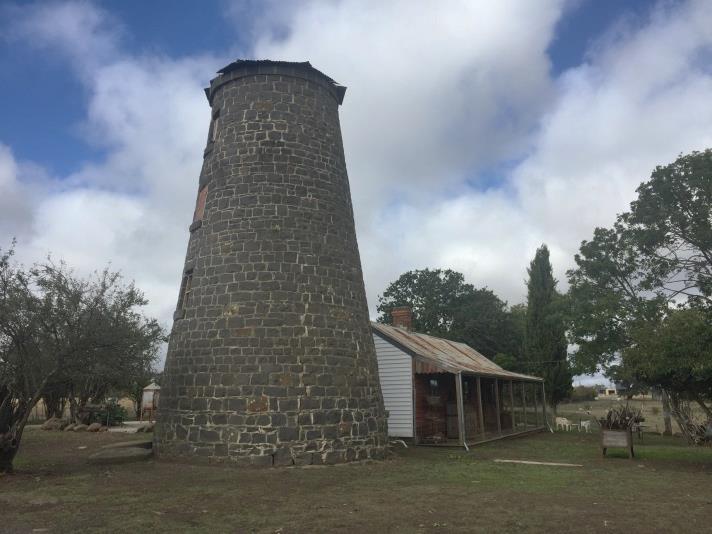
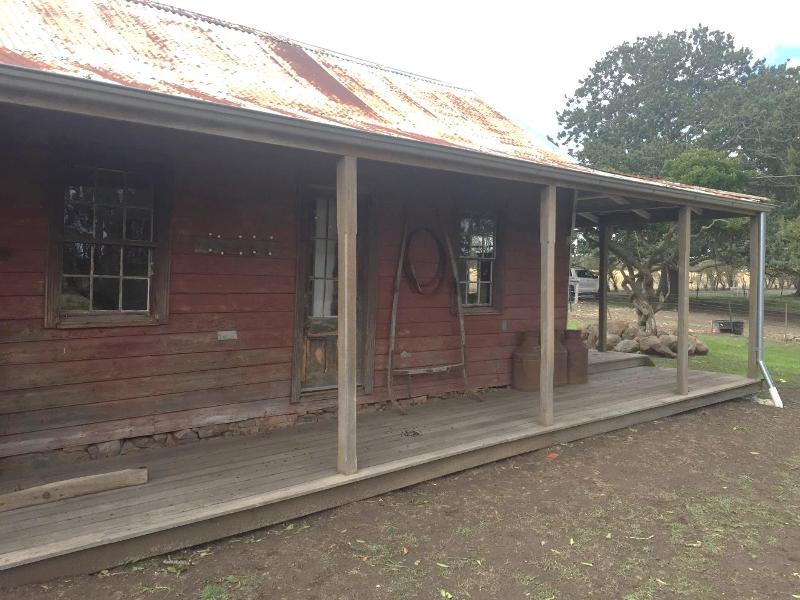
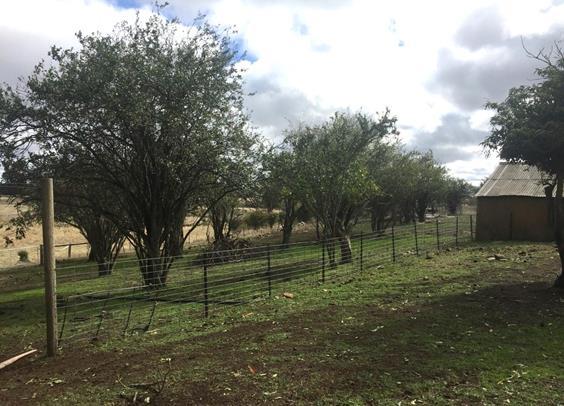
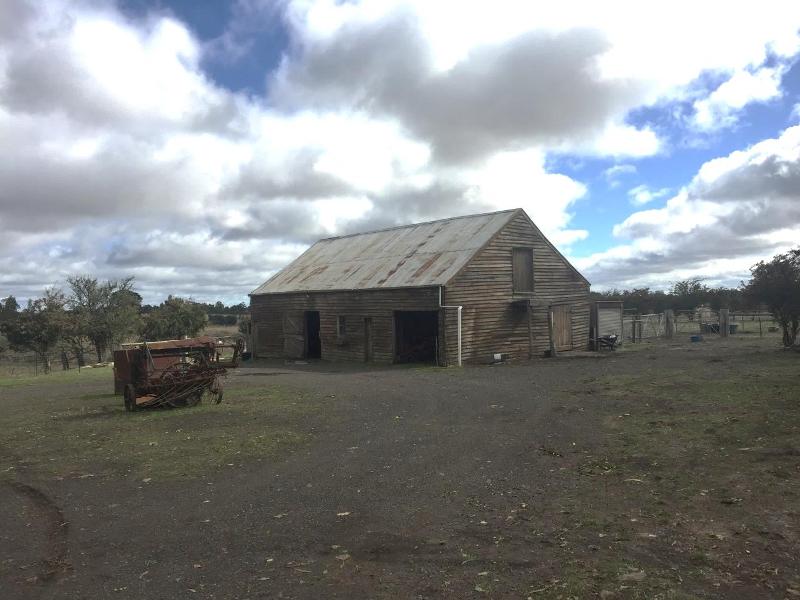

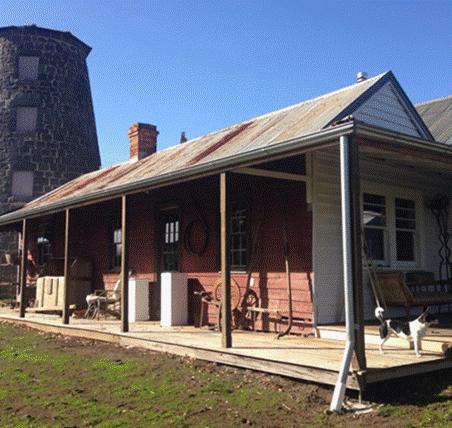

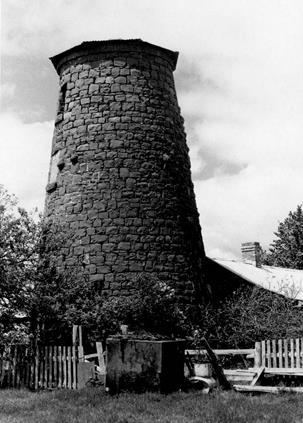





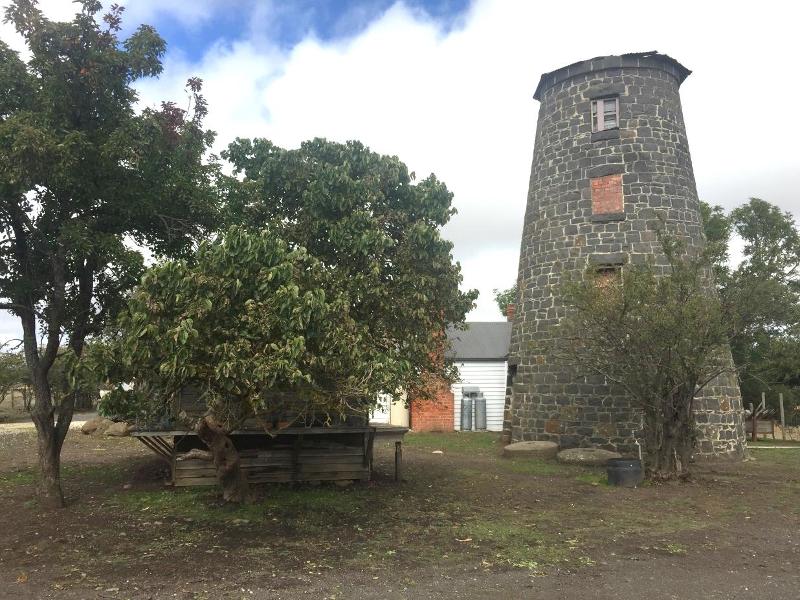

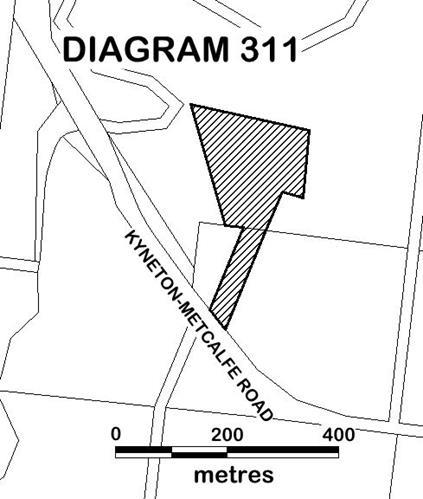
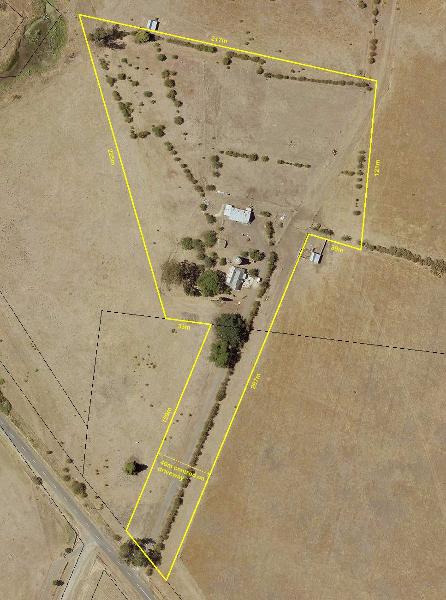
Statement of Significance
WHAT IS SIGNIFICANT?
Windmill Farm including the bluestone windmill tower, timber residence and barn, outbuildings and remnant trees and hedges.
History Summary
The land on which Windmill Farm is located was alienated from the Crown in 1855 by Joseph Hall who already had substantial land holdings in the area, including Park Hall and Sunbury Lodge, which was probably Hall's main residence. By this date, Kyneton and the surrounding districts were part of an important agricultural region and in 1856, at a cost of £3,160, Hall and his partner William Hoad, constructed a windmill on the property. It was one of the few mills in the area which relied on wind rather than steam power. The property was advertised for sale in 1857, and by this date a small two room timber cottage had been constructed and the windmill had been adapted to steam power. The sale was unsuccessful and the mill continued to operate only until the mid-1860s. Windmill Farm remained in Hall family ownership as a working farm. Hawthorn hedges were planted by the late 1860s, and a substantial farm building comprising stables, shearing shed, milking pen, garage, loft, yards and hay store was constructed in the early 1900s. The cottage was increased to more than double its size by the 1920s. In 1974, Windmill Farm passed to Hall family descendant, Robert Webster. On his death in 1983, his wife bequeathed the property to the National Trust of Australia (Victoria). In 2008, the Trust sold Windmill Farm and the subsequent owner completed restoration and reconstruction works to the cottage and outbuildings.
Description Summary
Windmill Farm comprises a farm complex that includes a bluestone windmill, small timber residence, substantial timber barn and smaller outbuildings. The windmill is a battered circular tower constructed of random coursed bluestone. There are four main levels, with openings arranged above each other. The openings have been boarded up and no milling machinery or the cap or sails survive. The timber residence is located to the immediate south of the windmill and has intersecting corrugated iron gabled roofs. It was constructed in stages, each of which are evident in the building fabric. A large stable complex is located to the north of the windmill, and smaller outbuildings, including one which is partially clad with flattened kerosene tins are located around the windmill and residence. The windmill, residence and outbuildings are located on a small rise which slopes away to the west towards the Campaspe River, making the complex a landmark within the area. Remnant plantings are evident around the windmill and farm buildings most of which, apart from a few older trees and the hawthorn hedges, were probably planted in the 1940s. The area to the west of the residence has a remnant fruit orchard, while the area to the east has a white gravel surfaced area.
This site is part of the traditional land of the Taungurung people.
HOW IS IT SIGNIFICANT?
Windmill Farm is of historical significance to the State of Victoria. It satisfies the following criteria for inclusion in the Victorian Heritage Register:
Criterion A
Importance to the course, or pattern, of Victoria's cultural history.
Criterion B
Possession of uncommon, rare or endangered aspects of Victoria's cultural history.
WHY IS IT SIGNIFICANT?
Windmill Farm is significant at the State level for the following reasons:
The windmill at Windmill Farm is historically significant as the last known windmill in a region which contained many mills in the mid nineteenth century. The residence and associated farm buildings contribute to an understanding of the development of the place, from its original use as a flour mill to a farm which was established in the 1860s and remained in the ownership of Hall family descendants until 1983. [Criterion A]
The windmill at Windmill Farm is Victoria's only known surviving wind-driven flour mill. Built in 1856, it is a rare example of a stone windmill base and was one of six of its type in Victoria in the 1850s. Its technology was derived from English practice and it was fitted with Cubitt patent shutter sails which represented the state of the art at that time. In Victoria this was a late use of wind technology which had been generally replaced elsewhere by steam. The mill is one of very few surviving in Australia. Other examples are at Brisbane (Qld.), Nimmitabel (NSW), Stirling (WA) and Oatlands (TAS). [Criterion B]
-
-
WINDMILL FARM - History
The land on which Windmill Farm is located was alienated from the Crown in 1855 by Joseph Hall who already had substantial land holdings in the area, including Park Hall and Sunbury Lodge, which was probably Hall's main residence. By this date, Kyneton and the surrounding districts were part of an important agricultural region and in 1856, at a cost of £3,160, Hall and his partner William Hoad, constructed a windmill on the property. It was one of the few mills in the area which relied on wind rather than steam power. The property was advertised for sale in 1857, and by this date a small two room timber cottage had been constructed and the windmill had been adapted to steam power. The sale was unsuccessful and the mill continued to operate only until the mid-1860s. Windmill Farm remained in Hall family ownership as a working farm. Hawthorn hedges were planted by the late 1860s, and a substantial farm building comprising stables, shearing shed, milking pen, garage, loft, yards and hay store was constructed in the early 1900s. The cottage was increased to more than double its size by the 1920s. In 1974, Windmill Farm passed to Hall family descendant, Robert Webster. On his death in 1983, his wife bequeathed the property to the National Trust of Australia (Victoria). In 2008, the Trust sold Windmill Farm and the subsequent owner completed restoration and reconstruction works to the cottage and outbuildings.
Key references
Bick, D; Kellaway, C; Patrick, J (ed: Treweeke, A) (1993) Windmill Farm Conservation Analysis
Bick, D; Kellaway, C; Patrick, J (1991) Windmill Farm Conservation Analysis
WINDMILL FARM - Permit Exemptions
General Exemptions:General exemptions apply to all places and objects included in the Victorian Heritage Register (VHR). General exemptions have been designed to allow everyday activities, maintenance and changes to your property, which don’t harm its cultural heritage significance, to proceed without the need to obtain approvals under the Heritage Act 2017.Places of worship: In some circumstances, you can alter a place of worship to accommodate religious practices without a permit, but you must notify the Executive Director of Heritage Victoria before you start the works or activities at least 20 business days before the works or activities are to commence.Subdivision/consolidation: Permit exemptions exist for some subdivisions and consolidations. If the subdivision or consolidation is in accordance with a planning permit granted under Part 4 of the Planning and Environment Act 1987 and the application for the planning permit was referred to the Executive Director of Heritage Victoria as a determining referral authority, a permit is not required.Specific exemptions may also apply to your registered place or object. If applicable, these are listed below. Specific exemptions are tailored to the conservation and management needs of an individual registered place or object and set out works and activities that are exempt from the requirements of a permit. Specific exemptions prevail if they conflict with general exemptions. Find out more about heritage permit exemptions here.Specific Exemptions:Permit exemptions (under section 42 of the Heritage Act)
It should be noted that Permit Exemptions can be granted at the time of registration (under s.42(4) of the Heritage Act). Permit Exemptions can also be applied for and granted after registration (under s.66 of the Heritage Act)
General Condition 1
All exempted alterations are to be planned and carried out in a manner which prevents damage to the fabric of the registered place or object.
General Condition 2
Should it become apparent during further inspection or the carrying out of works that original or previously hidden or inaccessible details of the place or object are revealed which relate to the significance of the place or object, then the exemption covering such works shall cease and Heritage Victoria shall be notified as soon as possible.
General Condition 3
All works should ideally be informed by Conservation Management Plans prepared for the place. The Executive Director is not bound by any Conservation Management Plan, and permits still must be obtained for works suggested in any Conservation Management Plan.
General Condition 4
Nothing in this determination prevents the Heritage Council from amending or rescinding all or any of the permit exemptions.
General Condition 5
Nothing in this determination exempts owners or their agents from the responsibility to seek relevant planning or building permits from the relevant responsible authority, where applicable.
Specific Permit Exemptions
Landscape Exemptions:
. Maintenance and care of existing plants.
. The process of gardening, including mowing, hedge clipping (including trimming and maintenance of the Hawthorn hedges), bedding displays, removal of dead shrubs and replanting the same species or cultivar.
. Disease and weed control including the removal of plants listed as noxious weeds (excluding the Hawthorn hedges) in the Catchment and Land Protection Act 1994.
. The removal or pruning of dead or dangerous trees to maintain safety and replanting with the same species or cultivar.
. Vegetation protection and management of possums and vermin.
. Subsurface works involving the installation, removal or replacement of watering and drainage systems or services provided that there is no detrimental effect on heritage fabric.
Exterior
. Minor patching, repair and maintenance which replace like with like.
. Removal of non-original items such as air conditioners, pipe work, ducting, wiring, antennae, aerials etc in a manner that does not damage the heritage fabric.
. Installation or removal of non-original external fixtures and fittings such as hot water services and taps in a manner that does not damage the heritage fabric.
. Painting of previously painted surfaces provided that preparation or painting does not remove the original paint or other decorative scheme.
Interior (residence and farm buildings only, excluding the windmill)
. Painting of previously painted walls and ceilings provided that preparation or painting does not remove any original paint or other decorative scheme.
. Installation, removal or replacement of non-original carpets and/or flexible floor coverings.
. Installation, removal or replacement of non-original curtain tracks, rods and blinds.
. Installation, removal or replacement of hooks, nails and other devices for the hanging of mirrors, paintings and other wall mounted art.
. Demolition or removal of non-original stud/partition walls, suspended ceilings or non-original wall linings (including plasterboard, laminate and Masonite), non-original glazed screens, non-original flush panel or part-glazed laminated doors, aluminium-framed windows, bathroom partitions and tiling, sanitary fixtures and fittings, kitchen wall tiling and equipment, lights, built-in cupboards, and the like.
. Removal of introduced door and window furniture including, hinges, locks, knobsets and sash lifts.
. Removal of glazing to internal timber-framed, double hung sash windows, and replacement with clear or plain opaque glass.
. Refurbishment of existing bathrooms, toilets and kitchens including removal, installation or replacement of sanitary fixtures and associated piping, mirrors, wall and floor coverings.
. Removal of non-original tiling or concrete slabs in wet areas provided there is no damage to or alteration of original structure or fabric.
. Installation, removal or replacement of ducted, hydronic or concealed radiant type heating provided that the installation does not damage original skirtings and architraves and that the central plant is concealed, and is done in a manner not detrimental to the cultural heritage significance of the place.
. Installation, removal or replacement of electrical wiring provided that all new wiring is fully concealed and any original light switches, pull cords, push buttons or power outlets are retained in-situ. Note: if wiring original to the place was carried in timber conduits then the conduits should remain in situ.
. Installation, removal or replacement of bulk insulation in the roof space.
Maintenance and Security
. General maintenance including the removal of broken glass, the temporary shuttering of windows and covering of holes as long as this work is reversible and does not have a detrimental impact on cultural heritage significance.
Agricultural activities
. Cultivation, cropping, harvesting, grazing stock, and other agricultural, pastoral, and viticultural activities.
. Maintenance, repair or removal of any fence, gate, dam or structure necessary for the continuation of agricultural or pastoral activities.
WINDMILL FARM - Permit Exemption Policy
Permit Policy
Preamble
The purpose of the Permit Policy is to assist when considering or making decisions regarding works to a registered place. It is recommended that any proposed works be discussed with an officer of Heritage Victoria prior to making a permit application. Discussing proposed works will assist in answering questions the owner may have and aid any decisions regarding works to the place.
The extent of registration of Windmill Farm in the Victorian Heritage Register affects the whole place shown on Diagram 311 including the land, all buildings (exteriors and interiors), driveway, trees, landscape elements and other features. Under the Heritage Act 1995 a person must not remove or demolish, damage or despoil, develop or alter or excavate, relocate or disturb the position of any part of a registered place or object without approval. It is acknowledged, however, that alterations and other works may be required to keep places and objects in good repair and adapt them for use into the future.
If a person wishes to undertake works or activities in relation to a registered place or registered object, they must apply to the Executive Director, Heritage Victoria for a permit. The purpose of a permit is to enable appropriate change to a place and to effectively manage adverse impacts on the cultural heritage significance of a place as a consequence of change. If an owner is uncertain whether a heritage permit is required, it is recommended that Heritage Victoria be contacted.
Permits are required for anything which alters the place or object, unless a permit exemption is granted. Permit exemptions usually cover routine maintenance and upkeep issues faced by owners as well as minor works or works to the elements of the place or object that are not significant. They may include appropriate works that are specified in a conservation management plan. Permit exemptions can be granted at the time of registration (under s.42 of the Heritage Act) or after registration (under s.66 of the Heritage Act).
It should be noted that the addition of new buildings to the registered place, as well as alterations to the interior and exterior of existing buildings requires a permit, unless a specific permit exemption is granted.
Cultural Heritage Management plans
There are two Conservation Analysis reports for Windmill Farm. The first was completed in 1991 followed by another in 1993. Both were prepared for the owners of the place, the National Trust of Australia (Victoria) by David Bick, Carlotta Kellaway and John Patrick. The latter report is a more succinct summary or the earlier report, however both reports contain relevant information and should be read in conjunction with each other. Given the age of these reports, and changes to the place, it is recommended that a Conservation Management Plan is developed to manage the place in a manner which respects its cultural heritage significance.
Aboriginal cultural heritage
If any Aboriginal cultural heritage is discovered or exposed at any time it is necessary to immediately contact Aboriginal Victoria to ascertain requirements under the Aboriginal Heritage Act 2006.
Other approvals
Please be aware that approval from other authorities (such as local government) may be required to undertake works.
Archaeology
Ground disturbance may affect any archaeological deposits of the place and, subject to the exemptions stated in this document, requires a permit.
-
-
-
-
-
WINDMILL FARM
 Victorian Heritage Register H0311
Victorian Heritage Register H0311 -
Windmill - Windmill Farm
 National Trust H0311
National Trust H0311
-
..esterville
 Yarra City
Yarra City -
1 Alfred Crescent
 Yarra City
Yarra City -
1 Barkly Street
 Yarra City
Yarra City
-
-











